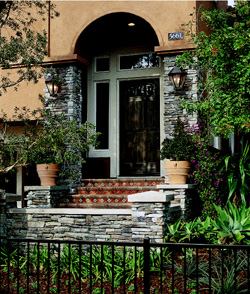A SIDE FROM THE ARCHITECTURE, it’s a house’s skin that gives it a distinct sense of place. Stucco siding and tile roofs are a natural fit in the South and West. Brick, stone, wood, and asphalt predominate in the Northeast and Midwest. The choices reflect what’s available at hand and what best withstands the prevailing climate, as well they should. But beyond the performance and price factors of exterior materials, builders are making sure their homes possess the ultimate sales clincher: curb appeal.
Faced with the need to quicken the pace of sales in some communities, and rigid design regulations by municipalities, many builders are limiting buyers’ choices of exterior upgrades, particularly in solidly middle-class markets. Increasingly, builders are instead designing for a gold standard by speccing locally appropriate products and accents that appeal to buyers across the board.
The relentless housing boom has been a key factor in altering the economics of exteriors for U.S. Home. In order to meet demand in its strongest markets, the builder is pouring slabs and preplanning homes ahead of purchase, which translates to fewer exterior choices for buyers. As a result, “we’re making sure the roofing and siding look so good and perform so well that there’s little incentive to make them better,” says Brian Hutt, national design studio director for U.S. Home in Houston. “The perceived value is already there.”
Buyers of Ryland’s $500,000 homes in Corona, Calif., pay about $1,000 more for the highest-priced elevation than the lowest-priced one. The difference in cost comes from the extra framing required to tweak porches and rooflines, rather than from materials, which typically include stucco, cultured stone, and brick. Farther east, in the builder’s Denver market, hard-board siding and cultured stone accents are standard.
Whether they live in the East or West, buyers are drawn to materials that add detail, texture, and heft. Ashton Woods Homes in Roswell, Ga., lets its customers upgrade from Hardiplank siding to wood shingles, brick, or Owens Corning cultured stone on the front or all four sides of a house. Design center manager Brian Carr says 50 percent of the buyers (first-time and move-up) purchase brick accents or front facades to jazz up the standard siding. Only 3 percent opt for brick or cultured stone on all four walls, which costs about $5,000 and $6,500, respectively. The builder’s CertainTeed shingles carry a 25-year warranty, and customers seem satisfied with the simple choice of two colors they’re offered, Carr says.
Using fiber cement technology to create a whole range of siding products, Nichiha is targeting the same market niche. “We’re not trying to be a substitute for brick or stone, but a viable alternative,” says Darrin Haugan, marketing liaison for Nichiha in Atlanta. This year it introduced Sierra Premium Smooth, a smooth lap siding in 7-inch and 8-and-one-half-inch profiles. Two other products—the Homestead vertical siding, which has a barn-like aesthetic, and Kura Stone, a clip-on panel that resembles stacked stone and can be installed by siding crews—will be brought to market later this year.
James Hardie Building Products of Mission Viejo, Calif., is giving builders another reason to spec its siding products—especially in northern markets—as an attractive, low-maintenance alternative to wood and vinyl. The company just completed its northern region rollout of Color Plus fiber cement siding in eight prefinished colors with a 15-year warranty on the finish in addition to the 50-year warranty it offers against warping. “The pre-finish option provides a lower on-the-wall cost to builders and puts them in a position to offer the 15-year warranty to buyers,” says John Dibski, director of marketing for the northern region. Rather than using it as an upgrade, “most builders are offering our products as standard so they can set their trades in place house to house.”
Thanks to 3M’s Scotchgard algae-resistant technology, builders may soon be able to offer a better value on asphalt shingles, too, which were used on more than half of new homes built in 2002, according to the National Roofing Contractors Association in Rosemont, Ill. 3M’s marketing manager Tim Worms says the treated granules, which are being marketed to roofing manufacturers, protect roofs for 20 years against the dark streaks caused by algae, compared to the 10 or 15 trouble-free years similar products provide. “Algae are seen on roofs in more than 80 percent of the U.S.,” Worms says. “The value comes in preventing the unsightly streaking, which can lead to increased maintenance costs and reduced property values. There’s an opportunity for builders to differentiate themselves and make additional money by offering this roof, much like an upgrade in carpeting.”



